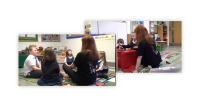Teaching which notes to play - Video
Music Resource Description
Teaching Which Notes to Play
If the children are new to playing instruments to accompany their singing, the activity will need careful explanation and modelling. The best instruments to use are individual chime bars because the children can concentrate just on the timing having too look carefully which notes to play. If you are using xylophones with removable bars, it helps to take off the bars not being used (be sure they are put back because they are easily lost).
Two notes are needed to accompany this song, D (for dragon) and C (for Chinese). D sounds right for most of the song but, for two phrases, it clashes with the tune and you need to change to C - see below which note to play when. Children do pick this up well if they have a visual cue and it need not be difficult to achieve - here, I’ve simply used little bears to show the pattern and the children latch onto it straight away.
- What shall we do with a Chinese dragon? (D)
- What shall we do with a Chinese dragon? (C)
- What shall we do with a Chinese dragon? (D)
- Early in the (C) morning (D)
- __
- Polish her scales and make them shiny (D)
- Polish her scales and make them shiny (C)
- Polish her scales and make them shiny (D)
- Early in the (C) morning (D)
- __
- Ask her what she'd like to eat for breakfast (D)
- Ask her what she'd like to eat for breakfast (C)
- Ask her what she'd like to eat for breakfast (D)
- Early in the (C) morning (D)
- ©Music-Playtime: Arts Enterprise Limited
Extension - Make up an intro (rhythm, pitch)
Help the children to make up an intro to each verse using just the notes D and A and some untuned percussion instruments, based on the word pattern of Here's a Chinese Dragon.


